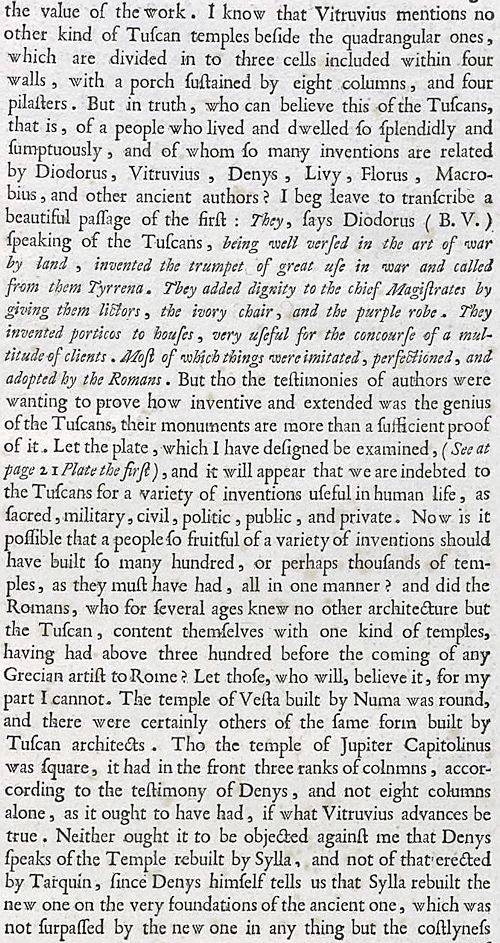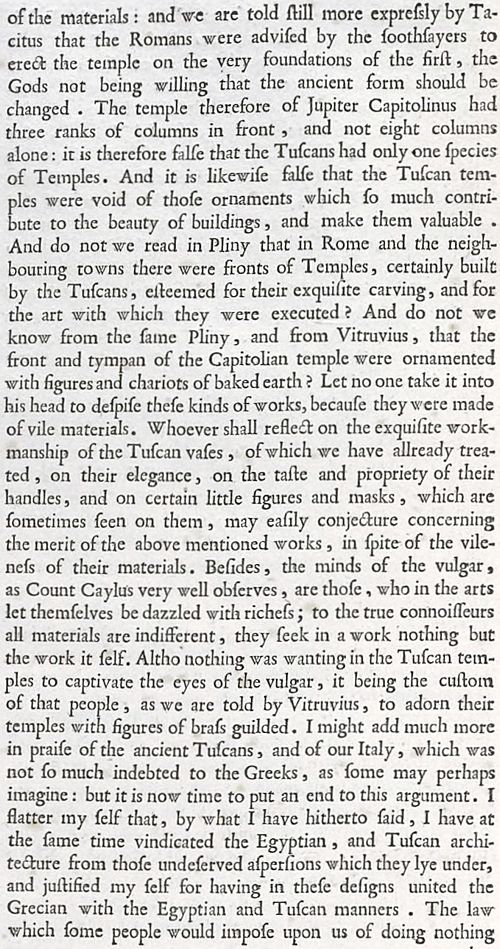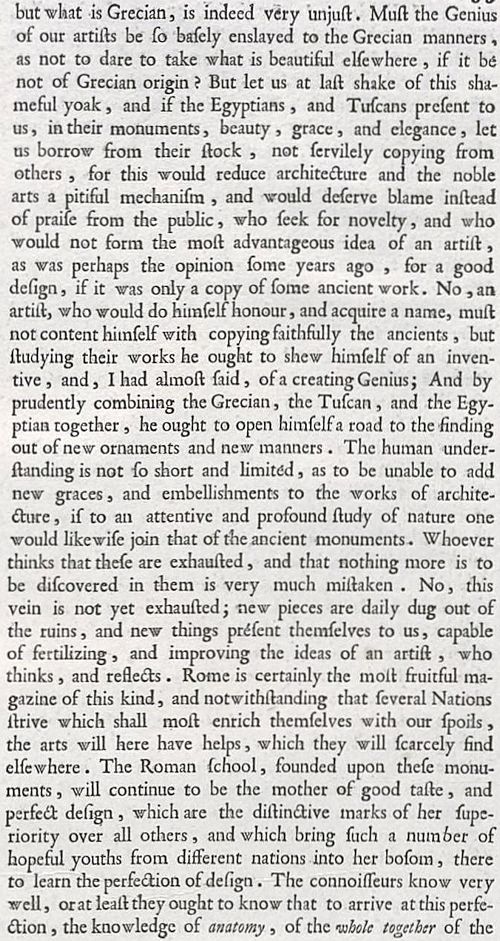
the value of the work. I know that Vitruvius mentions no other kind of Tuscan temples beside the quadrangular ones, which are divided into three cells included within four walls, with a porch sustained by eight columns, and four pilasters. But in truth, who can believe this of the Tuscans,
that is, of a people who lived and dwelled so splendidly and sumptuously, and of whom so many inventions are related by Diodorus, Vitruvius, Denys, Livy, Florus, Macrobius, and other ancient authors? I beg leave to transcribe a beautiful passage of the first: They, says Diodorus (B. V.) speaking of the Tuscans, being well versed in the art of war by land, invented the trumpet of great uwe in war and called from them Tyrrena. They added dignity to the chief Magistrates by giving them lictors, the ivory chair, and the purple robe. They invented porticos to houses, very useful for the concourse of a multitude of clients. Most of which things mere imitated, perfected, and adopted by the Romans. But tho the testimonies of authors were wanting to prove how inventive and extended was the genius of the Tuscans, their monuments are more than a sufficient proof of it. Let the plate, which I have degigned be examined, (See at page 21 Plate the first), and it will appear that we are indebted to the Tuscans for a variety of inventions useful in human life, as sacred, military, civil, politic, public, and private. Now is it
possible that a people so fruitful of a variety of inventions should have built so many hundred, or perhaps thousands of temples, as they must have had, all in one manner? And did the Romans, who for several ages knew no other architecture but the Tuscan, content themselves with one kind of temples, having had above three hundred before the coming of any Grecian artist to Rome? Let those, who will, believe it, for my part I cannot. The temple of Vesta built by Numa was round, and there were certainly others of the same form built by Tuscan architects. Tho the temple of Jupiter Capitolinus was square, it had in the front three ranks of colnmns, accorcording to the testimony of Denys, and not eight columns
alone, as it ought to have had, if what Vitruvius advances be true. Neither ought it to be objected against me that Denys speaks of the Temple rebuilt by Sylla, and not of that erected by Tarquin, since Denys himself tells us that Sylla rebuilt the new one on the very foundations of the ancient one, which was not surpassed by the new one in any thing but the costliness
| |

of the materials: and we are told still more expressly by Tacitus that the Romans were advised by the soothsayers to erect the temple on the very foundations of the first, the Gods not being willing that the ancient form should be changed. The temple therefore of Jupiter Capitolinus had
three ranks of columns in front, and not eight columns alone: it is therefore false that the Tuscans had only one species of Temples. And it is likewise false that the Tuscan temples were void of those ornaments which so much contribute to the beauty of buildings, and make them valuable.
And do not we read in Pliny that in Rome and the neighbouring towns there were fronts of Temples, certainly built by the Tuscans, esteemed for their exquisite carving, and for the art with which they were executed? And do not we know from the same Pliny, and from Vitruvius, that the
front and tympan of the Capitolian temple were ornamented with figures and chariots of baked earth? Let no one take it into his head to despise these kinds of works, because they were made of vile materials. Whoever shall reflect on the exquisite workmanship of the Tuscan vafes, of which we have already treated, on their elegance, on the tasle and propriety of their handles, and on certain little figures and masks, which are
sometimes seen on them, may easily conjecture concerning the merit of the above mentioned works, in spite of the vileness of their materials. Besides, the minds of the vulgar, as Count Caylus very well observes, are those, who in the arts let themfelves be dazzled with richess; to the true connoisseurs all materials are indifferent, they seek in a work nothing but the work itself. Although nothing was wanting in the Tuscan temples to captivate the eyes of the vulgar, it being the custom of that people, as we are told by Vitruvius, to adorn their temples with figures of brass guilded. I might add much more in praise of the ancient Tuscans, and of our Italy, which was not so much indebted to the Greeks, as some may perhaps imagine: but it is now time to put an end to this argument. I flatter myself that, by what I have hitherto said, I have at the same time vindicated the Egyptian, and Tuscan architecture from those undeserved aspersions which they lie under, and justified myself for having in these designs united the Grecian with the Egyptian and Tuscan manners. The law which some people would impose upon us of doing nothing
| |

but what is Grecian, is indeed very unjust. Must the genius of our artists be so basely enslaved to the Grecian manners, as not to dare to take what is beautiful elsewhere, if it be not of Grecian origin? But let us at last shake of this shameful yoak, and if the Egyptians, and Tuscans present to us, in their monuments, beauty, grace, and elegance, let us borrow from their stock, not servilely copying from others, for this would reduce architecture and the noble arts a pitiful mechanism, and would deserve blame instead of praise from the public, who seek for novelty, and who would not form the most advantageous idea of an artist, as was perhaps the opinion some years ago, for a good design, if it was only a copy of some ancient work. No, an artist, who would do himself honour, and acquire a name, must not content himself with copying faithfully the ancients, but studying their works he ought to show himself of an inventive, and, I had almost said, of a creating genius; And by prudently combining the Grecian, the Tuscan, and the Egyptian together, he ought to open himfelf a road to the finding out of new ornaments and new manners. The human understanding is not so short and limited, as to be unable to add new graces, and embellishments to the works of architecture, if to an attentive and profound study of nature one would likewise join that of the ancient monuments. Whoever thinks that these are exhausted, and that nothing more is to be discovered in them is very much mistaken. No, this vein is not yet exhausted; new pieces are daily dug out of the ruins, and new things present themselves to us, capable of fertilizing, and improving the ideas of an artist, who thinks, and reflects. Rome is certainly the most fruitful magazine of this kind, and notwithstanding that several nations strive which shall most enrich themselves with our spoils, the arts will here have helps, which they will scarcely find elsewhere. The Roman school, founded upon these monuments, will continue to be the mother of good taste, and perfect design, which are the distintive marks of her superiority over all others, and which bring such a number of hopeful youths from different nations into her bosom, there to learn the perfection of design. The connoisseurs know very well, or at least they ought to know that to arrive at this perfection, the knowledge of anatomy, of the whole together of the
|